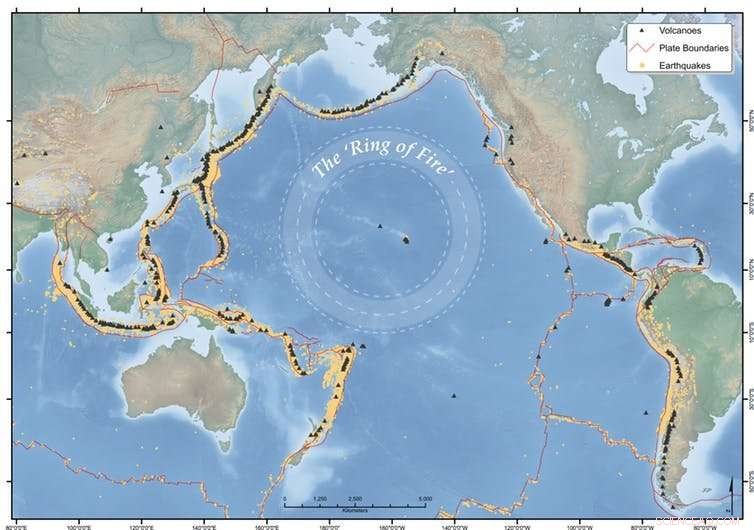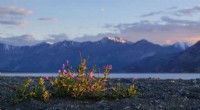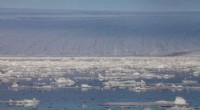Fem aktive vulkaner på min Asia Pacific Ring of Fire-overvågningsliste lige nu

Ildringen strækker sig rundt om Stillehavskanten i en hesteskoform. Kredit:Earth Observatory of Singapore
I Indonesien, mere end 197 millioner mennesker bor inden for 100 km fra en vulkan, inklusive mere end 8,6 millioner inden for en radius på 10 km.
Landet har en registrering af nogle af de mest dødelige vulkanudbrud i historien, og lige nu er der igangværende udbrud ved Agung, Sinabung og Dukono vulkanerne. Men andre vulkaner i regionen er også aktive, inklusive Kadovar i Papua Ny Guinea, Mayon i Filippinerne, og Kusatsu-Shiranesan i Japan.
Selvom det hele ser ud til at ske på én gang, det er normalt for Asien-Stillehavsområdet at have hyppige jordskælv og vulkansk aktivitet.
Men vi skal stadig holde et vågent øje med tingene, og lokale vulkanske myndigheder overvåger aktiviteten for at håndtere risici og evakueringer tilstrækkeligt.
Disse vulkaner er en del af Stillehavets "Ring of Fire", et hesteskoformet bælte af jordskælv og vulkaner, der løber i omkring 40, 000 km, omkring kanten af Stillehavet. Ringen strækker sig fra Sydamerika, op til Nordamerika og over Bering lige, og ned gennem Japan, Filippinerne, Papua Ny Guinea, Vanuatu og New Zealand. Det genererer omkring 90 % af verdens jordskælv og indeholder 75 % af dets aktive vulkaner.
Her er vulkanerne på min Asien-Pacific-overvågningsliste i denne uge.
Agung, Bali, Indonesien
Mount Agung på Bali har været meget gransket i de sidste par måneder, hovedsagelig på grund af Balis popularitet som turistdestination.
Efter en række vulkanske jordskælv (mere end 1, 000 pr. dag på sit højeste), udbrud begyndte den 21. november, 2017.
Siden da har vi set hyppige eksplosive udbrud, der udsender gas, damp og vulkansk aske når tusindvis af meter over vulkanen.
Droner brugt af det indonesiske center for vulkanologi og geologisk risikobegrænsning (CVGHM) viser anslået 20 millioner kubikmeter ny lava i krateret, fylder cirka en tredjedel af det.
Vores drone fløj over Mt Agungs krater. Lavavolumen på kraterskålen er forholdsvis uændret (~20 Mm3). Magmatiske gasser som CO2 &SO2 blev stadig detekteret, hvilket indikerer, at vulkanen sandsynligvis stadig vil gå i udbrud. Farezonen er estimeret inden for en radius af 6 km fra krateret. pic.twitter.com/D2GThP6fnC
— MAGMA Indonesia (@id_magma) 22. januar, 2018
Om aftenen den 19. januar skød en eksplosion af brand (kendt som et "strombolisk" udbrud) glødende sten op til 1 km fra krateret. Alarmniveauet forbliver på det højeste niveau, med en udelukkelseszone på plads.
Strombolian-udbrud af Mount Agung den 19. januar 2018, tid er angivet i videoen. Højden på askefanens top er omkring 2500 m over vulkanens top. @id_magma pic.twitter.com/HeihvYzT60
— Devy Kamil Syahbana (@_elangtimur) 19. januar, 2018
Der har været meget få problemer for turister, der besøger Bali indtil videre, bortset fra en midlertidig lukning af Denpasar lufthavn sidst i november 2017. tusindvis af Agungs lokale beboere er stadig fordrevet fra deres hjem, med mange stadig udstationeret i evakueringscentre. Det er fortsat usikkert, hvornår de nærmeste, der bor, kan vende hjem.
Mange evakuerede gravide kvinder har født babyer, siden de forlod deres hjem på steder som Bumi Sehats lokale sundhedscenter og fødselsklinik i Ubud, som er afhængig af donationer for at blive ved med at køre. Som mor til en et-årig og en tre-årig, Jeg kan ikke forestille mig at have en nyfødt baby og ikke være i komfort i mit eget hjem.
Sinabung, Sumatra, Indonesien
Sinabung-vulkanen vågnede i 2010 efter 400 års søvn, og er i øjeblikket en af de mest aktive vulkaner i Indonesien. Det har stort set været i konstant udbrud siden september 2013, og der er stadig hyppige vulkanske jordskælv.
Udbrud har produceret askefaner, der når så højt som 11 km op i atmosfæren, samt askefald og lavastrømme. Der har også været vulkanske mudderstrømme ("lahars") og hurtigt bevægende, varme gasstrømme, aske og stenfragmenter ("pyroklastiske strømme"), som har dræbt 25 mennesker.
Children play outside while Mount Sinabung #volcano spews huge plumes of smoke into the skies above the Indonesian island of #Sumatra pic.twitter.com/5Cm1E44WqC
— CGTN (@CGTNOfficial) January 28, 2018
The initial activity in 2010 saw around 30, 000 people evacuated. In August last year the Indonesian National Disaster Management Authority (BNPB) reported that there were 7, 214 people displaced, and a further 2, 863 living in refugee camps. For the locals, life seemingly goes on in the midst of eruptions.
The alert level currently remains at 4 (on a scale of 1-4), with exclusion zones of 3-7km around the volcano.
Mayon, Luzon, Philippines
Mayon, around 330km southeast of Manila, is a picture-perfect volcano with its steep-sided conical cone, typical of stratovolcanoes. It is one of the most active volcanoes in the Philippines, with 24 confirmed eruptive periods in the past 100 years. Mayon's most violent eruption in 1814 killed more than 1, 200 people and destroyed several towns.
The recent eruption began on January 13, 2018, and is continuing, with several episodes of dramatic lava fountaining, one lasting 74 minutes.
Eruptions during January 23-29 generated 3-5km-high ash plumes and multiple pyroclastic flows, which travelled more than 5km down drainage channels. The alert is at level 4 (on a scale of 1 to 5) and an 8km danger zone is in place.
Lava flows have currently made their way up to 4.5km down river valleys from the summit crater.
The Philippine Institute of Volcanology and Seismology (PHIVOLCS) estimated on January 27 that the total volume of material deposited from ash fall and pyroclastic flows amounted to 10.5 million cubic metres. Remobilisation of this loose volcanic material by rainfall to form volcanic mudflows is a major concern.
According to news articles, more than 75, 000 people have been evacuated, along with the temporary closure of Legazpi airport around 15km away.
Kadovar, Papua New Guinea
Until January 2018, when it began erupting, I hadn't heard of Kadovar. It's a 2km-wide, 365m-high emergent summit of a stratovolcano off the coast of Papua New Guinea.
The volcano had no confirmed historic eruptions before 2018. However, it is possible that William Dampier, a 17th-century pirate and later maritime adventurer, witnessed an eruption at Kadovar during a voyage in search of Terra Australis .
Activity began on January 5, 2018, with rising plumes of ash and steam from the volcano. The island's inhabitants, some literally living on the crater rim, began evacuating at that time. People were initially taken by boat to neighbouring Blup Blup island but then to the mainland along with other nearby islanders, due to the close proximity of the eruption and logistics of providing people with supplies.

The top 10 countries for population within 100 km of a volcano (left) and the top ten countries (area over 31, 415 km²) for percentage of the total population (right). Credit:Sarah Brown and co-authors
The Rabaul Volcano Observatory reported that activity significantly escalated on January 12, with a large explosive eruption and volcanic rocks ejected to the south. Large amounts of sulfur dioxide have been detected since January 8, and continue to be released along with ash and steam plumes. A lava "dome" has been observed glowing at night.
The impact from the eruption is not just confined to those on Kadovar and nearby islands, with satellite imagery tracking an ash plume from Kadovar travelling over tens of kilometres.
Identified volcanic risks at Kadovar include further potential explosive activity, jordskred, and resulting possible tsunamis.
Kusatsu-Shirane, Honshu Japan
On January 23, 2018, an eruption occurred at Kusatsu-Shirane volcano without any prior warning, catching Japan's Meteorological Agency and volcanic experts, not to mention the skiers on the volcano, by surprise.
Children play outside while Mount Sinabung #volcano spews huge plumes of smoke into the skies above the Indonesian island of #Sumatra pic.twitter.com/5Cm1E44WqC
— CGTN (@CGTNOfficial) January 28, 2018
According to agency's volcanology division, there had been no volcanic activity at the apparent site of the eruption (Kagamiike crater), for about 3, 000 år.
The eruption ejected a black plume of ash and larger volcanic material that damaged a gondola and the roof of a mountain lodge.
The ejected volcanic rocks, which landed up to 1km away from the vent, injured several people. A member of the Ground Self-Defence Force who was skiing in a training exercise was killed.
The Japan Meteorological Agency has since analysed the deposits of the eruption and state that there was no new magma erupted on January 23.
Japan has more than 100 active volcanoes, with many monitored 24/7 by Japan's Meteorological Agency.
Living near volcanoes
Indonesien, the Philippines and Japan have the greatest numbers of people living within 100km of their volcanoes. The populations of small volcanic island nations, such as Tonga and Samoa, almost all live within 100km.
Indonesia has the greatest total population located within 10km (more than 8.6 million), 30km (more than 68 million) and 100km (more than 179 million), and a record of some of the most deadly volcanic eruptions in history.
The eruption of Tambora in 1812-15, was the largest eruption in the last 10, 000 years and killed around 100, 000 Indonesians (due to the eruption and the ensuing famine). The infamous eruption of Krakatau (Krakatoa) killed an estimated 35, 000 mennesker, almost all due to volcanic-generated tsunamis. Volcanic mudflows (lahars) generated by the eruptions of 1586 and 1919 at Kelut (Kelud) in Java took the lives of 10, 000 and 5, 000 mennesker, henholdsvis.
Keeping watch on the world's volcanoes is a big job for the local volcanic agencies. This is particularly true when volcanoes erupt for the first time in history (Kadovar is a good example) or there were no warning signals before eruption, as at Kusatsu-Shirane.
Denne artikel blev oprindeligt publiceret på The Conversation. Læs den originale artikel. 
Sidste artikelForskning afdækker narhvalers mystiske liv
Næste artikelSavannabrande pumper centralafrikanske skove fulde af nitrogen
 Varme artikler
Varme artikler
-
 Tidlig smeltning af vintersnefald fremmer det arktiske forårForårsplanter i dele af den arktiske tundra ankommer tidligere end i tidligere årtier, på grund af tidlig smeltning af vintersne og stigende temperaturer, ifølge en undersøgelse ledet af forskere fra
Tidlig smeltning af vintersnefald fremmer det arktiske forårForårsplanter i dele af den arktiske tundra ankommer tidligere end i tidligere årtier, på grund af tidlig smeltning af vintersne og stigende temperaturer, ifølge en undersøgelse ledet af forskere fra -
 Naturlig algepopulation kan forklare, hvordan miljøændringer påvirker de globale kulstofcyklusserTransmissionselektronmikroskopibillede af Ostreococcus tauri -stammen RCC4221. Kredit:Martin Hohmann-Marriott Selvom de er usynlige for det blotte øje, bittesmå grønne alger kaldet Ostreococcus sp
Naturlig algepopulation kan forklare, hvordan miljøændringer påvirker de globale kulstofcyklusserTransmissionselektronmikroskopibillede af Ostreococcus tauri -stammen RCC4221. Kredit:Martin Hohmann-Marriott Selvom de er usynlige for det blotte øje, bittesmå grønne alger kaldet Ostreococcus sp -
 Pesticider og industrielle forurenende stoffer findes i sne oven på de arktiske gletschereEt af fire undersøgelsessteder, Austfonna er blandt de største iskapper i verden, med et areal på lidt over 3, 200 kvadratkilometer. Kredit:Andreas Weith/Wikimedia Commons Forskere fandt for nylig
Pesticider og industrielle forurenende stoffer findes i sne oven på de arktiske gletschereEt af fire undersøgelsessteder, Austfonna er blandt de største iskapper i verden, med et areal på lidt over 3, 200 kvadratkilometer. Kredit:Andreas Weith/Wikimedia Commons Forskere fandt for nylig -
 Nedgang i arktisk havis driver havets fytoplankton længere mod nordDette billede i ægte farver, fanget af NOAA-20 satellitten den 30. juli, 2018, viser en stor planteplanktonblomstring i Barentshavet. Kredit:NOAA Environmental Visualization Laboratory Fytoplankto
Nedgang i arktisk havis driver havets fytoplankton længere mod nordDette billede i ægte farver, fanget af NOAA-20 satellitten den 30. juli, 2018, viser en stor planteplanktonblomstring i Barentshavet. Kredit:NOAA Environmental Visualization Laboratory Fytoplankto
- Team så, hvordan en angriber kunne kapre Android -kamera til spyfest
- Ny undersøgelse finder, at atmosfæriske floder øger snemassen i Vestantarktis
- Brug af nye materialer til at lave mere pålidelige nanoelektromekaniske systemer
- Microneedle plaster leverer lokaliseret cancerimmunterapi til melanom
- Frankrig undersøger Boeings sorte bokse som jetfly på jorden over hele verden (opdatering)
- Cassini sender de første billeder fra en ny bane


